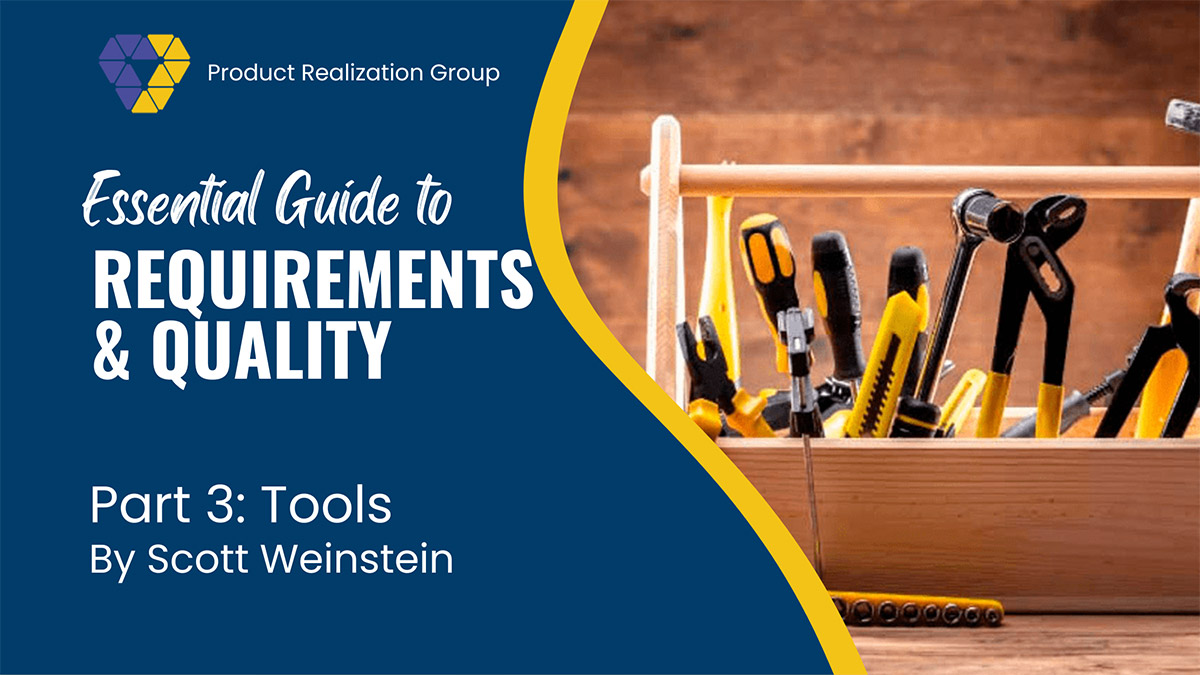
Expert Insights on Defining Requirements and Quality in Hardware

Scott Weinstein, Quality & Reliability, Principal Consultant at Product Realization Group
Scott Weinstein is a hardware development and manufacturing veteran with 25+ years of experience leading quality and reliability engineering programs at global companies, including Roku, Ford, Whirlpool, Keurig, Sonos, Harman, and Johnson Controls. A quality leader, Scott specializes in product design and operations for high-tech hardware companies. Scott has an MBA from the Worcester Polytechnic Institute and a Bachelor in Electrical Engineering from the Georgia Institute of Technology.
In the third part of Scott Weinstein’s series on quality, we will explore the tools and plans utilized by teams to deliver exceptional results. There are three crucial tools to develop and measure quality requirements:
- Failure Modes & Effects Analysis (FMEA) is a systematic approach to identifying and preventing product and process problems before they occur
- Correlation Matrix is a tool that shows the relationship between two or more sets of data
- Control Plan: a document that describes the actions to be taken, resources to be applied, and procedures to be followed for a particular process or product
Failure Modes & Effects Analysis (FMEA)
Process and Design FMEAs identify potential failure modes and prioritize them based on risk. For instance, in the automotive industry, a potential failure mode could be a brake failure, which is a high-risk issue that needs immediate attention.
FMEA is used to identify Special Characteristics and drive design and process controls through FMEAs, including verification and validation tests.
Correlation Matrix
A Correlation Matrix correlates the Special Characteristics you identified in your Design FMEA to the Process Parameters you identified in your Process FMEA. Your control plan should include both. These Process Parameters enable you to meet the Product Characteristics important to your customer.
Control Plan
The Control Plan is a precise tool used to identify all the Product Characteristics and Process Parameters needed during the manufacturing process. This tool will also determine which characteristics are Special, how they should be controlled, and what equipment will be used to measure the characteristics, giving you confidence in your manufacturing process.
The control method for Special Characteristics should use Statistical Process Control (SPC) and for the equipment used for measuring those Special Characteristics, Measurement System Analysis (MSA) or Gage Repeatability & Reproducibility (GR&R) should be used to ensure the measurement equipment is capable.
How do we measure requirement compliance?
Once we have requirements, we need to measure compliance with those requirements.
When verifying or validating a product during Product Development or testing a product during Mass Production, we need to measure or test something to determine if we meet or exceed these requirements. Product Characteristics and Process Parameters are identified in the Requirements documents (Product Requirements, Engineering Requirements, and Manufacturing Requirements).
The requirements can be measured as attributes, such as pass/fail, or as variables, which are estimated values. Further, the measurement methods can be easily derived if the Product and Manufacturing Requirements are clearly defined.
Test requirements should also be developed for each requirement during Requirement Definition, verification, and validation. These tests will make up the test plan for each development build (prototype, engineering, design, pre-production). These tests or inspections could be anything from a simple visual inspection requirement to a complex measurement method, performance test, or reliability test.
Conclusion
Failure Modes & Effects Analysis (FMEA), Correlation Matrix, and Control Plan are the three significant tools that can help in identifying potential failure modes, prioritizing them based on risk, and determining the most critical issues that need to be addressed to reduce risk. These tools can also help identify the product characteristics and process parameters needed during the manufacturing process and ensure that the measurement equipment used is capable of doing so. By developing test requirements for each requirement during Requirement Definition, verification, and validation, it is possible to ensure that these requirements are met or exceeded. Overall, the use of these engineering and quality tools can help develop and measure quality requirements, which are essential for ensuring that the product meets the customer’s needs and expectations.
Attempting to assess the quality of a new product without the necessary requirements is akin to driving to a new location without a map. Although you may have a general idea of the directions and may ultimately reach your destination, it will be a faster, less expensive, and easier journey if you use a map. Please join us next week for an in-depth analysis of how requirements should be defined for the best business outcomes.
Are you curious how to improve your hardware product’s quality and reliability? Contact us for a free consultation today. Or read on and learn more about Agile hardware development from the experts at Product Realization Group.
- Unlocking the Power of Quality: Expert Insights on Defining Quality in Hardware
- Unlocking Effective Quality Measurement: Hierarchical Requirements Definition
- Gaining Efficiency: Key Insights From A Large Company NPDI Assessment
- 10 Best Practices for Managing Hardware Development Risk
- 10 Critical Warning Signs Your New Product Development is at Risk


